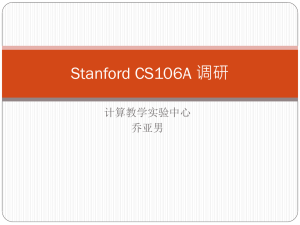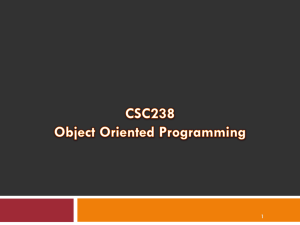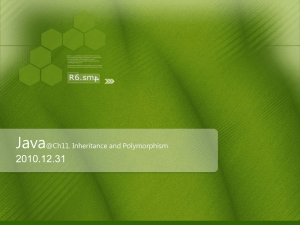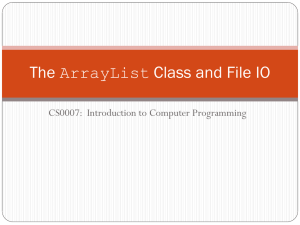Lecture 7
advertisement
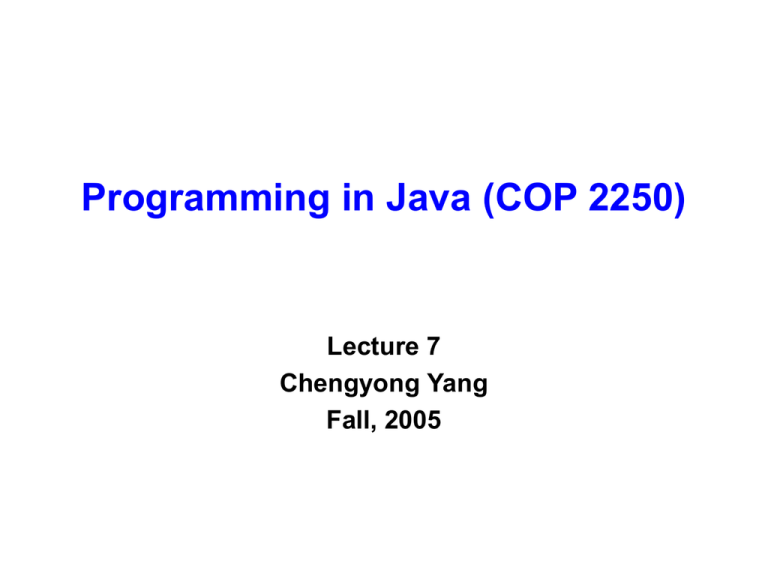
Programming in Java (COP 2250) Lecture 7 Chengyong Yang Fall, 2005 Chapter 3 Packages Formatting Output Enumerated Types Wrapper Classes 7-2 Class Libraries • A class library is a collection of classes that we can use when developing programs • The Java standard class library is part of any Java development environment • Its classes are not part of the Java language per se, but we rely on them heavily • Various classes we've already used (System , Scanner, String) are part of the Java standard class library • Other class libraries can be obtained through third party vendors, or you can create them yourself 7-3 Packages • The classes of the Java standard class library are organized into packages • Some of the packages in the standard class library are: Package Purpose java.lang java.applet java.awt javax.swing java.net java.util javax.xml.parsers General support Creating applets for the web Graphics and graphical user interfaces Additional graphics capabilities Network communication Utilities XML document processing 7-4 The import Declaration • When you want to use a class from a package, you could use its fully qualified name java.util.Scanner • Or you can import the class, and then use just the class name import java.util.Scanner; • To import all classes in a particular package, you can use the * wildcard character import java.util.*; 7-5 The import Declaration • All classes of the java.lang package are imported automatically into all programs • It's as if all programs contain the following line: import java.lang.*; • That's why we didn't have to import the System or String classes explicitly in earlier programs • The Scanner class, on the other hand, is part of the java.util package, and therefore must be imported 7-6 The Random Class • The Random class is part of the java.util package • It provides methods that generate pseudorandom numbers • A Random object performs complicated calculations based on a seed value to produce a stream of seemingly random values • See RandomNumbers.java (page 126) 7-7 The Math Class • The Math class is part of the java.lang package • The Math class contains methods that perform various mathematical functions • These include: – absolute value – square root – exponentiation – trigonometric functions 7-8 The Math Class • The methods of the Math class are static methods (also called class methods) • Static methods can be invoked through the class name – no object of the Math class is needed value = Math.cos(90) + Math.sqrt(delta); • See Quadratic.java (page 129) • We discuss static methods further in Chapter 6 7-9 Chapter 3 Packages Formatting Output Enumerated Types Wrapper Classes 7-10 Formatting Output • It is often necessary to format values in certain ways so that they can be presented properly • The Java standard class library contains classes that provide formatting capabilities • The NumberFormat class allows you to format values as currency or percentages • The DecimalFormat class allows you to format values based on a pattern • Both are part of the java.text package 7-11 Formatting Output • The NumberFormat class has static methods that return a formatter object getCurrencyInstance() getPercentInstance() • Each formatter object has a method called format that returns a string with the specified information in the appropriate format • See Purchase.java (page 131) 7-12 Formatting Output • The DecimalFormat class can be used to format a floating point value in various ways • For example, you can specify that the number should be truncated to three decimal places • The constructor of the DecimalFormat class takes a string that represents a pattern for the formatted number • See CircleStats.java (page 134) 7-13



